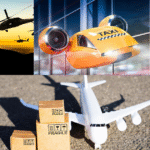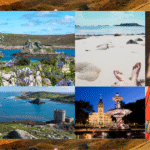Table of Contents
Introduction:

Welcome to Part 3 of our Ultimate Wild Series, Alaska, where the untamed beauty of Alaska continues to blow our minds—and hopefully, yours too!
In this edition, we’re heading straight to the water for two absolutely epic experiences you won’t want to miss.
First up?
Whale Watching in Juneau—where giants of the ocean break the surface in jaw-dropping displays that will leave you speechless.
Whether it’s humpbacks bubble-net feeding or orcas gliding through icy waters, it’s a front-row seat to grab seeking to enjoy nature’s power and grace.
Next, we’re grabbing a paddle and venturing into the serenity of Prince William Sound.
Kayaking here is like entering another world—gliding past massive tidewater glaciers, spotting seals sunbathing on icebergs, and soaking in the silence of Alaska’s remote coastline vistas.
From close encounters with marine wildlife to peaceful paddles through glacier-carved fjords, Part 3 is all about experiencing Alaska’s wild waters, up close and unforgettable.
Strap in, splash out, and let’s explore!
1. Whale Watching in Juneau

If witnessing a 40-ton humpback whale leap out of the ocean sounds like something off your wildest dream list—guess what? In Juneau, Alaska, it’s just another unforgettable day on the water. As part of our Ultimate Wild Series, we’re excited to share with you why this activity should be at the top of your bucket list.
Why Whale Watching in Juneau is a Must-Do
Juneau isn’t just Alaska’s capital; it’s one of the world’s top whale-watching destinations.
When it comes to world-class whale-watching, Juneau, Alaska holds a top spot—not just in Alaska, but globally. Within and around Juneau, there are several incredible whale-watching hotspots where travelers are almost guaranteed unforgettable sightings, especially during peak season (May through September).
Here are some of the top whale-watching destinations in and near Juneau:
Auke Bay
This is Juneau’s primary launching point for most whale-watching tours. Just 12 miles north of downtown Juneau, Auke Bay offers easy access to nutrient-rich waters where you can teem with humpback whales, orcas, and other marine wildlife. Many tours begin from here because it’s so close to well-known feeding areas of these apex predators.
Stephens Passage
This long channel of water just off Juneau’s coast is considered one of the best places in the world to witness bubble-net feeding, a coordinated hunting technique performed by humpback whales. Wildlife cruises through Stephens Passage often yield close sightings of whales breaching, tail-slapping, and spouting.
What Is Bubble-Net Feeding?
Bubble-net feeding is a cooperative and highly sophisticated hunting technique used by humpback whales to catch pools of small fish, appearing towards the radar in cluster—technique known as herring or krill. It’s one of the most incredible natural spectacles you can witness in the wild, and Juneau, Alaska, is one of the few places in the world where this behavior of humpbacks can be regularly observed from sighting zones.
How Does It Work?
Here’s the step-by-step breakdown of this awe-inspiring teamwork:
Herding the Fish
A group of humpbacks (often 5–15 whales) work together to locate a dense school of fish below the surface. Humpback whale will swim in a circular motion, releasing a stream of bubbles from its blowhole.
Diving Deep
The whales dive below the school and begin to swim in a circular motion, blowing bubbles as they go.
Spinning a Net of Bubbles
As the whales circle below, they release streams of bubbles that rise and form a “net,” corralling the fish into a tight, frantic ball—right before the big gulp!
The Lunge
Once the fish are concentrated in one spot, the whales surge upward through the bubble net, mouths wide open, scooping massive amounts of fish and water.
Filtering the Catch
With a single sweep, humpbacks use their baleen like giant strainers—pushing out the water and gulping down a mouthful of fish in one epic bite. Then they do it all over again! The bubbles create a barrier that traps the prey, preventing them from escaping.
Why Is It So Special?
It’s Rare: Only a few populations of humpbacks around the world use bubble-net feeding, and it’s believed to be a learned behavior passed through generations.
It’s well coordinated: Each whale has a role, some blow bubbles, some vocalize to direct fish, and others lunge. It’s like watching a perfectly timed dance.
You Can See It in Juneau! Southeast Alaska, especially Stephens Passage near Juneau, is one of the only places where tourists regularly see this phenomenon on whale-watching tours.
Why is Bubble Net Feeding Important?
Efficient feeding strategy: Bubble net feeding allows humpback whales to efficiently feed on large amounts of prey.
Social behavior: Bubble net feeding is often observed in groups of humpback whales, highlighting their social behavior and exciting nature.
Ecological significance: Humpback whales play a crucial role in maintaining the balance of marine ecosystems, and bubble net feeding is an important aspect of their feeding behavior.
Note:
Bubble net feeding has also been observed in other locations, such as Hawaii, Mexico, and the Caribbean Islands.
Fun Fact:
Each whale in the group has its own unique call during bubble-net feeding. Scientists believe these vocalizations help synchronize the group’s timing, kind of like nature’s version of a dinner bell
Lynn Canal
Despite its name, Lynn Canal is actually one of the deepest fjords in North America. It’s a migratory corridor for marine life, especially humpback whales traveling between the Gulf of Alaska and Southeast Alaska’s protected bays.
Favorite Channel
Located between Shelter Island and the mainland, this waterway is a prime zone for spotting orcas as well as humpbacks. Fewer boats mean more peace—giving you a front-row seat to the whales in a calm, uncrowded setting that feels like your own private show.
Inside Passage
While the Inside Passage covers a vast area of Southeast Alaska, the portion around Juneau is particularly rich with marine life. This route is part of many multi-day cruises and eco-tours and is ideal for seeing whales, sea lions, porpoises, and bald eagles—all in one trip.
Mendenhall Glacier
This glacier is a stunning backdrop for whale watching, with humpback whales often seen swimming in the waters below.
Tracy Arm Fjord
This narrow fjord is home to stunning glaciers and an abundance of wildlife, including humpback whales, orcas, and sea otters.
Admiralty Island
This island is a haven for wildlife, including humpback whales, which can be seen swimming in the surrounding waters.
Gastineau Channel
This channel is a popular spot for whale watching, with humpback whales and orcas frequently seen.
Douglas Island
This island is a great spot for whale watching, with humpback whales and other marine life often spotted.
Juneau Icefield
This icefield is home to stunning glaciers and an abundance of wildlife, including humpback whales.
Thanks to the rich, cold waters of the Inside Passage, it’s a natural hotspot for humpback whales, orcas, Dall’s porpoises, and more.
From mid-April to September, these majestic creatures return to Alaska’s coastal waters to feed—and you get to witness it all up close.
Juneau, Alaska, is a paradise for wildlife enthusiasts, and whale watching is one of the top attractions.
The city’s unique location in the Inside Passage provides a front-row seat to the majestic humpback whales, as well as other marine life like orcas, gray whales, and even sea otters.
With its stunning natural beauty and abundant wildlife, Juneau is an ideal destination for nature lovers and adventure-seekers alike. So, go gaga and crazy at your extreme Alaska expedition once more via our Part 3 episode.
What Makes It So Amazing?
Bubble-Net Feeding: Watch as humpbacks work together in an incredible feeding strategy that looks like choreographed magic. It’s rare. It’s powerful. And yes—it’s mind-blowing.
Close Encounters: Most tours guarantee whale sightings and many boats are small and nimble enough to get you right where the action is.
Unreal Scenery: Snow-capped peaks, emerald forests, and crystal waters frame every unforgettable moment.
Whale watching in Juneau is an experience you’ll never forget. Imagine being surrounded by the serene waters of the Inside Passage, with the majestic humpback whales swimming alongside your boat.
You’ll have the opportunity to see these gentle giants up close, feeding on krill and small fish, and even breaching the water’s surface. It’s the kind of jaw-dropping moment that stops you in your tracks and stays with you forever.
Characteristics of the Inside Passage:
Pro Tips for the Best Experience
Book a Small-Group Tour: You’ll have a more personal and immersive experience (plus better photo angles).
Bring Binoculars & Zoom Lens: Even with close encounters, a little zoom goes a long way.
Dress in Layers: It’s Alaska—sunshine and showers can trade places within the hour. Even in the summer months, the Alaskan waters can be chilly, so be sure to dress in layers and bring a warm hat and gloves.
Go Mid-Summer: July and August are peak times for sightings and behavior like breaching and feeding.
Choose a reputable tour operator: Look for companies that have experienced guides, small group sizes, and a focus on responsible wildlife viewing.
Juneau, Alaska, offers a variety of reputable whale-watching tour operators, each providing unique experiences to witness the majestic marine life of the region. Here are some reputable tour operators for whale watching in Juneau.
Harv and Marv’s Outback Alaska: Offers 3-hour whale watching tours with an additional hour of viewing time compared to other operators. Their smaller boats provide a more intimate experience, and each tour includes a bonus stop to view one of Alaska’s breathtaking glaciers.
Jayleen’s Alaska: Provides personalized tours on custom six-passenger vessels, ensuring a close and comfortable experience with whales. Their captains are lifelong working with Alaskans coastlines with extensive knowledge of the area.
Alaska Luxury Tours: Offers exclusive, luxury whale watching experiences on high-end yachts, complete with offerings such as harcuterie, champagne, and beer from the Alaskan Brewing Co. They prioritize responsible and sustainable tourism practices.
Gastineau Guiding Company: Specializes in small-group whale watching and hiking excursions, led by passionate and knowledgeable guides. They offer customized private tours for families or groups.
Alaska Shore Excursions: Features a variety of whale watching tours, including combinations with Mendenhall Glacier visits and delicious cuisine offerings such as salmon bakes, a traditional Alaskan cooking method where fresh salmon is slow-cooked over an open flame, often on a large cedar plank or in a pit oven. There are guides and eligible locals who provide expert knowledge and insights of Alaskan traditional legacy.
Bring binoculars: You’ll want to get a closer look at the whales and other marine life, so don’t forget your binoculars.
Be prepared for variable weather: Juneau’s weather can be unpredictable, so be sure to pack a waterproof jacket and pants.
Summer months (May–September) are the best time to spot whales. Look for bubble-net feeding, a rare and fascinating hunting technique.
Key Takeaways
Best Time to Go: May–September (Peak action in July & August)
Top Species to Spot: Humpback whales, orcas, sea lions, and harbor seals
Where it all begins: Auke Bay in Juneau is your gateway to unforgettable whale-watching adventures.
Experience Type: Family-friendly, photo-worthy, and soul-stirring!
Best time to visit: The best time to see humpback whales in Juneau is from May to September, when the waters are calm and the whales are feeding on krill and small fish.
Types of whales: In addition to humpback whales, you may also see orcas, gray whales, and minke whales in Juneau’s waters.
Responsible wildlife viewing: Be sure to choose a tour operator that follows responsible wildlife viewing practices, such as keeping a safe distance from the whales and not feeding them.
Fun Fact to Wow Your Friends
Did you know?
Humpback whales can grow up to 60 feet long, weigh over 40 tons, and travel more than 3,000 miles each year just to reach Alaska’s feeding grounds. Now that’s dedication to dinner.
Humpback whales can grow up to 50 feet long: That’s longer than a school bus!
Whales can eat up to 1.5 tons of food per day: Humpback whales are filter feeders, using their baleen plates to strain tiny fish and krill from the water.
Juneau is home to a large population of humpback whales: In fact, the city’s waters are a critical habitat for these majestic creatures.
2. Kayaking in Prince William Sound

If Alaska had a crown jewel for sea kayakers, Prince William Sound would be shining the brightest way.
Picture paddling through peaceful, iceberg-dotted waters, with snowcapped mountains soaring above and seals lounging on floating ice just feet away.
Welcome to one of the most surreal outdoor adventures in the Last Frontier, a kayaking experience like no otherworldly match.
Look no further than kayaking in Prince William Sound, Alaska!
As part of our Ultimate Wild Series Part 3, we’re excited to share some valid facts and details with and ensure that why this adventurous activity should be at the top of your bucket list.
Why You Should Visit:
Prince William Sound is a kayaker’s paradise, with its stunning glaciers, majestic mountains, and abundant wildlife.
The sound is a vast, protected waterway that’s home to an incredible array of marine life, including sea otters, seals, and whales. With its unique combination of natural beauty and wildlife viewing opportunities, Prince William Sound is an unmissable destination for kayaking enthusiasts worldwide.
Because it’s otherworldly.
Prince William Sound is nature’s masterpiece. With over 3,800 miles of coastline, this vast marine playground is filled with fjords, tidewater glaciers, quiet coves, and hidden beaches. It’s serene, wild, and bursting with abundance of creatures full of life.
Prince William Sound in Alaska is a breathtaking destination, featuring stunning fjords, tidewater glaciers, quiet coves, and hidden beaches. Each offering a different piece of Alaska’s wild heart. Here’s a snapshot of some of the standout features you can experience in this magical place
Fjords
Fjords are long, deep, narrow inlets with steep cliffs, formed by glacial erosion—and Prince William Sound is packed with them.
College Fjord: One of the most iconic, it boasts several tidewater glaciers named after Ivy League schools (e.g., Harvard, Yale, Smith). It’s dramatic, serene, and often teeming with wildlife.
Barry Arm Fjord: A lesser-known gem near Barry Glacier, perfect for kayaking and spotting seals lounging on icebergs.
Harriman Fjord: A narrow, dramatic passage lined with glaciers and waterfalls; named during the famous Harriman Expedition.
Passage Canal: A narrow fjord connecting Prince William Sound to the Gulf of Alaska, offering breathtaking views of glaciers and wildlife.
Blackstone Bay: A serene fjord with stunning glacier views, perfect for kayaking or boat tours.
Tidewater Glaciers: These are glaciers that flow directly into the sea, often gives birth to icebergs that flow in the water.
Columbia Glacier: One of the largest tidewater glaciers in North America, constantly active and visually stunning.
Meares Glacier: A relatively stable glacier near Valdez, known for its towering ice wall and vivid blue hue.
Chenega Glacier: A popular glacier among kayakers; it often calves ice dramatically into Nassau Fjord.
Wellesley Glacier: A 4.5-mile-long glacier flowing from the Chugach Mountains into College Fjord.
Harriman Glacier: A majestic tidewater glacier in Harriman Fjord, known for its stunning calving displays.
Surprise and Barry Glacier: Two impressive tidewater glaciers in Harriman Fjord, accessible by boat or kayak.
Quiet Coves & Inlets
These calm, protected waters are ideal for kayaking, camping, and watching marine wildlife.
Eshamy Bay: A peaceful and remote cove often used by kayak campers and anglers.
Hobo Bay: A hidden gem where vibrant marine life meets breathtaking mountain backdrops—a pure Alaskan magic in every direction to be delighted with.
Shotgun Cove: Close to Whittier, it offers easy access with breathtaking views and quiet paddling.
Lagoon: A tranquil, shallow body of water near Wellesley Glacier, perfect for kayaking or paddle boarding.
Hidden Beaches
These aren’t your typical sandy beaches, but they are beautiful, wild shorelines perfect for picnic exploration spots, or just soaking in the breathtaking view.
Blackstone Bay Beaches: Gravelly beaches (shoreline composed primarily of coarse, loose, water-worn gravel, pebbles, and cobbles, rather than sand) nestled among waterfalls and glaciers, a true hidden paradise.
Canoe Passage beaches: Soft pebble and driftwood-lined stretches amid mammoth coastline landscape, ideal for breaks on multi-day kayak tours.
Derickson Bay Shores: Remote and scenic, these beaches are surrounded by alpine backdrops and great for spotting sea otters.
Fun Tip:
Many of these areas are accessible only by boat or kayak, which adds to their remote charm. Guided kayaking or glacier cruise tours from Whittier or Valdez are the best ways to explore these areas safely.
Whether you’re gliding past towering ice walls or watching sea otters drift by, the intimacy of a kayak brings you closer to Alaska’s beauty than any cruise or tour ever could.
Why it’s amazing:
Glide through crystal-clear waters framed by massive glaciers, as seals, otters, and seabirds turn the scene into a living postcard.
Seals, otters, and even whales may pop up right next to your kayak territory!
Paddle past active glaciers like Columbia and Meares as they calve thunderously into the sea.
Columbia Glacier:
Location: Columbia Glacier is located in Prince William Sound, Alaska, near the town of Valdez.
Size: The glacier covers an area of approximately 220 square miles (570 square kilometers).
Type: Columbia Glacier is a powerful tidewater glacier—surging straight into the sea in a dramatic, icy cluster display.
Calving: The glacier is known for its dramatic calving displays, where large chunks of ice break off and crash into the water.
Recession: Columbia Glacier has been receding rapidly in recent years, exposing new landscapes and creating opportunities for breathtaking coastline exploration for enthusiast.
Meares Glacier
Location: Meares Glacier is located in the Chugach Mountains, near the town of Valdez, Alaska.
Size: The glacier covers an area of approximately 10 square miles (26 square kilometers).
Type: Meares Glacier is a classic valley glacier, carving its way through rugged mountain corridors like nature’s frozen river meeting the horizon.
Accessibility: The glacier is accessible by hiking or kayaking, offering stunning views and opportunities for exploration.
Scenic beauty: Meares Glacier is known for its picturesque surroundings, including towering mountains and serene lakes.
Encounter incredible wildlife, from bald eagles overhead to humpback whales breaching in the distance.
Explore remote spots where motorboats can’t go, like secluded inlets, kelp forests, and waterfall-fed lagoons.
Here are some must-explore remote spots in Prince William Sound where motorboats can’t easily go or aren’t allowed:
Eshamy Lagoon
Why it’s special: This secluded spot is protected by narrow, shallow channels that block larger boats. It’s a calm, glassy paradise filled with tide pools, sea stars, and incredible bird watching.
Access: Best reached by kayak from Eshamy Bay or guided multi-day tours.
Culross Passage & Culross Island Coves
Why it’s special: This narrow, forested passage offers several inlets and hidden beaches too shallow or tight for motorboats. It’s known for serene paddling and possible black bear sightings along the shore.
Access: Great for kayak camping; many guided kayaking trips are inclusive in this area for early bookings.
Blackstone Bay Back Channels
Why it’s special: While the main bay sees cruise tours and smaller boats, there are intricate glacier-fed creeks and winding backwaters in this area that only kayaks can navigate.
Access: Launch from Whittier and paddle into the less-traveled arms of the bay.
Dual Head & Hobo Bay
Why it’s special: This area has narrow coves and tight spots between rocky outcroppings that are best explored quietly by paddle. Wildlife thrives dense in these untouched zones.
Access: Often accessed on kayak camping routes from Whittier or by water taxi drop-off.
Nassau Fjord (Near Chenega Glacier)
Why it’s special: Some of the iceberg-laden waters and inner stretches of Nassau Fjord can become too packed or shallow for motorboats. It’s a surreal place to paddle among floating ice and echoing glacier sounds.
Access: Via guided kayak tours or drop-offs by smaller vessels.
Note: Companies like Lazy Otter Charters or Alaska Sea Kayakers in Whittier offer travel support for off-grid thrill loving adventures.
Soak in total silence—just you, your paddle, and the rhythmic sound of nature.
Kayaking in Prince William Sound is an experience you’ll never forget.
Picture yourself kayaking across glassy waters, with colossal glaciers on one side and mighty mountains rising all around—pure Alaskan awe at every stroke.
You’ll also have the opportunity to see other incredible array of wildlife, such as bears, moose, and eagles.
Pro Tip:
Dress in layers and waterproof gear to stay warm and dry. Guided tours offer the safest and most scenic routes.
Dress smart and warmly – Think waterproof layers, a dry bag, and a warm hat. Weather changes fast! Even in the summer months, the Alaskan waters can be chilly, so be sure to dress in layers and bring a warm hat and gloves. Prince William Sound’s weather can be unpredictable, so be sure to pack a waterproof jacket and pants.
Go with a guide – Local experts not only enhance safety but share deep knowledge of the area’s wildlife and geology.
Start in Whittier or Valdez – These two towns are the most popular jumping-off points with excellent kayak rental and tour services availability.
Pack light snacks and a thermos – Nothing beats sipping a hot cocoa in front of a glacier, icebergs.
Bring binoculars: You’ll want to get a closer look at the wildlife and unparalleled beauty of towering glaciers, so don’t forget your binoculars.
Fun Facts to Paddle Around With:
Prince William Sound has more tidewater glaciers than anywhere else in North America.
Harbor seals often rest on icebergs—so don’t be surprised if your kayak glides right past them.
The Sound is named after Prince William Henry, who later became King William IV of the Republic Of United Kingdom.
It was the site of the 1989 Exxon Valdez oil spill, but years of recovery efforts have helped wildlife rebound dramatically.
Note:
On March 24, 1989, disaster struck when the Exxon Valdez oil tanker slammed into Bligh Reef in Prince William Sound, igniting one of the worst environmental crises in U.S. history.
It was carrying over 53 million gallons of crude oil, and an estimated 11 million gallons spilled into the ocean.
The Impact:
1,300 miles of coastline were affected.
The spill claimed the lives of over 250,000 seabirds, nearly 3,000 sea otters, and countless seals and bald eagles—leaving a haunting scar on Alaska’s wildlife.
Fishing communities were devastated—especially for herring and salmon.
The local Alaska Native communities suffered cultural and subsistence losses.
The ecosystem took decades to begin recovering, and some areas still show traces of oil today.
Aftermath & Response:
The disaster led to major reforms, including the Oil Pollution Act of 1990, which improved spill response and increased tanker safety standards.
Exxon was ordered to pay billions in cleanup, damages, and fines, although legal battles dragged on for years.
The Exxon Valdez spill remains a powerful reminder of how fragile and valuable Alaska’s wild landscapes and part of marine ecosystems. It sparked global awareness and pushes initiative for long-term efforts to protect coastal environments.
Prince William Sound is home to the largest concentration of sea otters in North America:
These adorable creatures are a delight to watch, and Prince William Sound is one of the best places to see them.
The sound is surrounded by stunning glaciers: Prince William Sound is home to some of the most stunning glaciers in Alaska, including the famous Columbia Glacier.
The sound is a popular destination for kayakers: Prince William Sound is a popular destination for kayakers, with its calm waters and stunning scenery making it an ideal location for paddling.
Key Takeaways:
Unmatched Scenery: You’ll paddle through movie-worthy backdrops every stroke of the way.
Wildlife Encounters: It’s not unusual to see otters, puffins, whales, and even bears on shore.
All Skill Levels Welcome: From half-day trips to multi-day expeditions, there’s something for everyone.
When to Go: May through September is prime time in Prince William Sound—mild temps, long days, and wildlife galore make it an outdoor dream come true.
Types of kayaking tours: There are a variety of kayaking tours available, including guided tours, self-guided tours, and multi-day expeditions.
Here are some options to consider:
Day Tours
Valdez Glacier Tour: A relaxing paddle on a lake with an easy hike to the glacier, opportunity to explore icebergs and a glacial cave ($89+ per day).
Duck Flats Tour: A 3-4 hour tour offering the opportunity to explore wildlife, including sea lions and otters, and Valdez history ($89+ per day).
Kittiwake Tour: A 3-hour tour includes introduction to sea kayaking, exploring the Kittiwake rookery and rugged surrounding coastline ($95+ per person).
Passage Canal Tour: A full-day tour of exploring waterfalls, hidden coves, and glacial views ($185+ per person).
Shotgun Cove Tour: A 5-hour tour kayaking through sheltered waters, opportunity to explore small coves, and enjoying scenic views ($285+ per person).
Blackstone Bay Tour: A full-day tour where you can paddling through ice floes, exploring glaciated areas, and spotting wildlife ($395+ per person).
Multi-Day Tours
2-Day Ocean Wilderness Camping: Explore Prince William Sound’s serene Culross Passage or stunning Hanging Glaciers of Blackstone Bay, with camping and gear provided ($999+ per person).
NOLS Sea Kayaking Trip: A 7-day trip with fascinating opportunity to explore Prince William Sound’s wilderness, with opportunities for hiking, fishing, and wildlife spotting ($2,795+ per person).
Custom and Guided Tours
Lazy Otter Guided Kayak Tours: Explore Prince William Sound’s calm waters and rugged coastline with a guided tour ($400+ per person for an 8-hour tour).
Alaska Sea Kayakers: Customizable tours and guided kayaking trips for all skill levels, including multi-day expeditions, split tours.
Pro Tips:
Dress in layers and waterproof gear—weather can change quickly.
Always book with a certified guide for safety and local insight.
Summer months (June to August) offer the best conditions.
Conclusion:
Alaska, you’ve got our hearts! From the majestic humpback whales of Juneau to the serene waters of Prince William Sound, we’ve explored the wildest adventures this incredible state has to offer. Alaska is adventure in its purest form. These epic experiences don’t just fill your camera roll—they feed your spirit straight from the bottom of your heart that will give you immense pleasure and joy in every arch of an breathtaking coastline journey that we unleashes in our Part3 wild series.
Whether you’re chasing whale songs or gliding past ancient ice, Part 3 of our Ultimate Wild Series proves that Alaska isn’t just a destination—it’s a story you get to live.
Stay tuned for more thrilling destinations and experiences in our Ultimate Wild Series as we are about to unleash our next exciting episode in Part 4 Series.
FAQs:
When’s the ultimate time to catch whales in action around Juneau?
The best time for whale watching in Juneau is from May to September, when humpback whales are most active. The calm summer waters make spotting them magical.
Do I need kayaking experience to explore Prince William Sound?
No, you don’t need prior kayaking experience to explore Prince William Sound. Guided tours are available for all skill levels. These guided tours are inclusive for every level—from chill paddles near coves to glacier-side adventures for thrill seekers.
How close do boats get to whales in Juneau?
Tours maintain a respectful distance (per federal guidelines), but whales often come close on their own. You might even feel the splash! Vessels are required to keep a minimum distance of 100 yards from humpback whales and other protected wildlife—giving these majestic creatures the space they deserve.
Is it worth booking both experiences on the same trip?
Absolutely! Whale watching stirs your soul, and kayaking brings you peace. Together, they deliver the ultimate Alaska adventure you’ll never forget. Many tour operators offer combination packages for whale watching and kayaking, guaranteeing whale sightings. Some tours start from Anchorage, making it easy to plan your trip.
Do I need special gear for these adventures?
Not really—most tour companies provide everything you need, including dry suits for kayaking and binoculars for whale watching. For whale watching, just bring layers, a waterproof jacket, and your camera. For kayaking in Prince William Sound, tour operators usually provide kayaks, paddles, life vests, and even dry suits or splash gear if needed. Just show up that you are ready for adventure and they’ll handle the rest where unbound thrill is everlasting!







